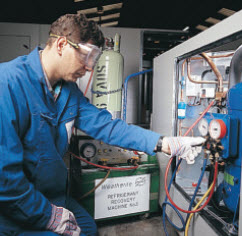by Nick Barnard — How can facilities managers meet the Carbon Reduction Commitment without spending £millions? The best approach is most likely by a combination of measures. One simple solution is to use pre cooling to save energy. Savings of up to 50 percent cooling energy can be achieved by opening windows early in the day and the preceding night to pre cool buildings. The cooling introduced early on is stored in the building fabric then released later in the day when it is needed. This reduces the amount of cooling energy required to maintain comfort temperatures. Peak summer temperatures can be reduced in buildings with heating only.
This sounds easy in theory but is rarely achieved in practice. People’s natural instinct is to leave windows closed in the morning when it is comfortable, and only open them later when it becomes warm. By this time temperatures have risen outside and it is too late. Predictive pre cooling strategies that alert occupants to the need for and availability of pre cooling would help to realise the potential benefits.
Free and Pre Cooling
In many buildings free cooling is introduced by opening windows to let in cool air when outside temperatures are below inside. Instinctively people open windows when it becomes warm inside. Pre cooling is the opening of windows before this time, to introduce cooling before it is needed and store it in the building fabric for later. This requires an element of anticipation or prediction.
On cool days free cooling can meet all the cooling load throughout the day without the need for any pre cooling (top diagram).
|
|
On warm days there is less free cooling available, particularly later in the day (middle diagram). However, more than enough may be available earlier in the day due to lower outside temperatures, providing the opportunity for pre cooling. This pre cooling is absorbed and stored by the building fabric (walls, ceilings, floors, etc). As the space temperature increases later in the day this pre cooling is released, reducing the cooling load and/or restricting temperature rise.
On hot days there may only be limited free cooling available in the morning and no opportunity for pre cooling earlier in the day (bottom diagram). It may be possible to pre cool during the preceding night (often referred to as night cooling), though this will often be ruled out on practical grounds.
Pre cooling restricted to the morning occupied period will still have a major energy benefit during warm weather and can typically be expected to reduce cooling energy by 30 percent.
Pre cooling at night
At night many buildings will be unoccupied so there are no occupants to open and close windows. There are also likely to be additional security concerns regarding open windows in an unoccupied building at night. For these reasons it may be expected that it will only be practical to pre cool in most buildings during the morning occupied period. Specialist automated systems are often installed to provide pre cooling during the night. These systems can typically be expected to reduce cooling energy by 50 percent1. Because they provide cooling on the hottest days they will also reduce peak cooling demands in air conditioned buildings and peak temperatures in heating only buildings (typically by 3°C1).
Predictive Pre Cooling
Strategies to realise the benefits of pre cooling can be developed for the coming period on the basis of:
- the hourly predicted building cooling load, and
- the hourly free cooling available from the outside.
Comparison of these hourly values enables periods when there is a shortfall of free cooling v cooling load to be identified, triggering a need for pre cooling. This will normally occur later in the day. A pre cooling schedule during the preceding morning and night to store cooling to meet this shortfall can then be developed.
The strategy should also warn when it is too cold, too hot or too humid outside and window opening should be minimised to avoid wasting heating and cooling energy.
Free data
Predictive pre cooling control strategies may be calculated using weather forecasts as the basis for the predicted values. Strategies for locations in the UK and throughout the world are available free at www.lowcarboncomfort.com. The website also provides guidance on further reducing heating and cooling by using adaptive comfort temperatures.
Nick Barnard was formerly Technical Director at AECOM Buildings, and at the end of last year set up www.lowcarboncomfort.com to provide data and guidance to help save energy and improve comfort in buildings. Data to optimise building operation is updated hourly based on weather forecasts and can be accessed via the website.
1Institute of Refrigeration Paper: Hybrid Cooling Solutions: Night Cooling and Mechanical Refrigeration.
